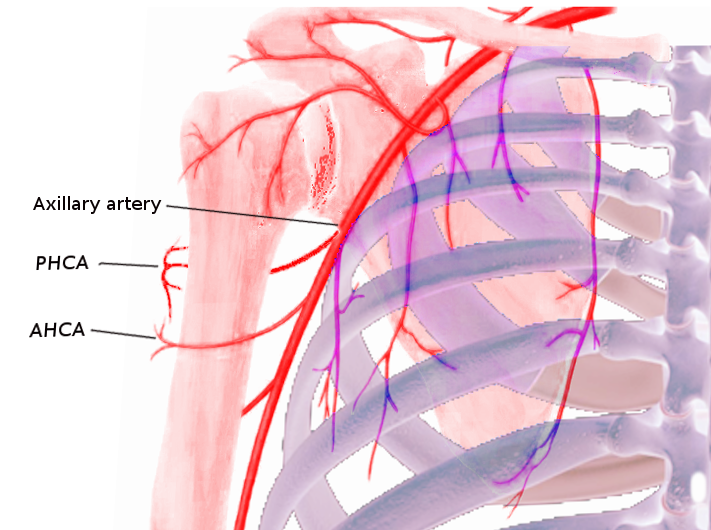[1]
Chen YF, Zhu NF, Zhang CQ, Wang L, Wei HF, Lu Y. The relevance of the anatomical basis of fracture for the subsequent treatment of the anterior humeral circumflex artery and the axillary nerve. International orthopaedics. 2012 Apr:36(4):783-7. doi: 10.1007/s00264-011-1394-4. Epub 2011 Dec 24
[PubMed PMID: 22198360]
[2]
Thiel R, Munjal A, Daly DT. Anatomy, Shoulder and Upper Limb, Axillary Artery. StatPearls. 2023 Jan:():
[PubMed PMID: 29489298]
[3]
Tang A, Varacallo M. Anatomy, Head and Neck, Posterior Humeral Circumflex Artery. StatPearls. 2023 Jan:():
[PubMed PMID: 30855867]
[4]
Chen YX, Zhu Y, Wu FH, Zheng X, Wangyang YF, Yuan H, Xie XX, Li DY, Wang CJ, Shi HF. Anatomical study of simple landmarks for guiding the quick access to humeral circumflex arteries. BMC surgery. 2014 Jun 26:14():39. doi: 10.1186/1471-2482-14-39. Epub 2014 Jun 26
[PubMed PMID: 24970300]
[5]
Mostafa E, Imonugo O, Varacallo M. Anatomy, Shoulder and Upper Limb, Humerus. StatPearls. 2023 Jan:():
[PubMed PMID: 30521242]
[6]
Hettrich CM, Boraiah S, Dyke JP, Neviaser A, Helfet DL, Lorich DG. Quantitative assessment of the vascularity of the proximal part of the humerus. The Journal of bone and joint surgery. American volume. 2010 Apr:92(4):943-8. doi: 10.2106/JBJS.H.01144. Epub
[PubMed PMID: 20360519]
[8]
Lee H, Bang J, Kim S, Yang H. The axillary vein and its tributaries are not in the mirror image of the axillary artery and its branches. PloS one. 2019:14(1):e0210464. doi: 10.1371/journal.pone.0210464. Epub 2019 Jan 10
[PubMed PMID: 30629680]
[9]
Terabayashi N, Watanabe T, Matsumoto K, Takigami I, Ito Y, Fukuta M, Akiyama H, Shimizu K. Increased blood flow in the anterior humeral circumflex artery correlates with night pain in patients with rotator cuff tear. Journal of orthopaedic science : official journal of the Japanese Orthopaedic Association. 2014 Sep:19(5):744-9. doi: 10.1007/s00776-014-0604-5. Epub 2014 Jul 29
[PubMed PMID: 25069807]
[10]
Tashjian RZ. Epidemiology, natural history, and indications for treatment of rotator cuff tears. Clinics in sports medicine. 2012 Oct:31(4):589-604. doi: 10.1016/j.csm.2012.07.001. Epub 2012 Aug 30
[PubMed PMID: 23040548]
[12]
Hagiwara Y, Kanazawa K, Ando A, Nimura A, Watanabe T, Majima K, Akita K, Itoi E. Blood flow changes of the anterior humeral circumflex artery decrease with the scapula in internal rotation. Knee surgery, sports traumatology, arthroscopy : official journal of the ESSKA. 2015 May:23(5):1467-72. doi: 10.1007/s00167-013-2823-2. Epub 2014 Jan 5
[PubMed PMID: 24390057]
[13]
Schumaier A, Grawe B. Proximal Humerus Fractures: Evaluation and Management in the Elderly Patient. Geriatric orthopaedic surgery & rehabilitation. 2018:9():2151458517750516. doi: 10.1177/2151458517750516. Epub 2018 Jan 25
[PubMed PMID: 29399372]
[14]
Shah R, Koris J, Wazir A, Srinivasan SS. Anterior humeral circumflex artery avulsion with brachial plexus injury following an isolated traumatic anterior shoulder dislocation. BMJ case reports. 2016 Mar 11:2016():. doi: 10.1136/bcr-2015-213497. Epub 2016 Mar 11
[PubMed PMID: 26969353]
Level 3 (low-level) evidence

